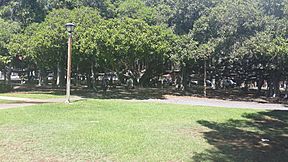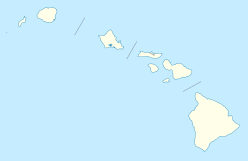Banyan tree in Lahaina facts for kids
Quick facts for kids Banyan tree in Lahaina |
|
|---|---|

Full view of the banyan tree with 16 major trunks apart from the main trunk
|
|
| Species | Banyan (Ficus benghalensis) |
| Coordinates | 20°53′10″N 156°40′29″W / 20.886111°N 156.674722°W |
The banyan tree in Lahaina, located in Maui, Hawaii, is a very famous and huge tree. It was planted on April 24, 1873. This special tree marked 50 years since the first American Protestant missionaries arrived.
Known as paniana in Hawaiian, this banyan tree (Ficus benghalensis) is in Courthouse Square. This area is now called Banyan Tree Park. It covers almost two acres of land. This tree is the biggest in Hawaii and even in the entire United States! Missionaries from India gave it as a gift. When first planted, it was only 8 feet (2.4 m) tall. Now, it stands about 60 feet (18 m) high. It has grown 16 large trunks besides its main one. Its wide top, called a canopy, spreads over about 0.66 acres (0.27 ha).
In 2023, wildfires badly damaged the town of Lahaina. The banyan tree was also severely hurt. Experts called arborists checked the tree. They believe it has a good chance to grow back. To help it heal, they are giving it water, compost, and airing out its soil. They expect to see results in a few months.
Contents
History of the Lahaina Banyan Tree
This amazing banyan tree is near the port in Lahaina. Lahaina was once the capital of Hawaii. This makes it the oldest banyan tree in all of Hawaii.
The Smith family received the banyan tree as a gift in the 1870s. William Owen Smith, who was the sheriff of Lahaina, planted it on April 24, 1873. This planting celebrated 50 years since the first Protestant mission came to Maui. Queen Keōpūolani, wife of King Kamehameha I, had invited the mission to Maui.
The tree's many trunks and aerial roots now cover about 0.66 acres (0.27 ha). It is located in what was Courthouse Square. This area is now known as Banyan Tree Park. The park itself covers 1.94 acres. This banyan tree is the largest in Hawaii and the United States. The County of Maui and the Lahaina Restoration Foundation take care of the park.
Reports say a royal party was held under the tree in 1886. This was for King Kamehameha III's birthday. The Aloha Festivals Week has also taken place under this tree. Its shade is perfect for vendors who hold events almost every weekend.
At sunset, the tree becomes very noisy. Birds fly back to find the best branches to sleep on. Many people think this huge tree is actually many trees grown together. But it is just one tree with many trunks!
There used to be a water canal along one side of the tree. Even though it's now a street, people think it still helps water the tree's roots. To help the roots grow faster, people used to tie jars of water to them. The roots would reach for the water, helping them grow towards the ground.
What Makes Banyan Trees Special?
The banyan tree, or Ficus benghalensis, comes from India. It is famous for how its roots grow. Roots grow down from the branches towards the ground. These are called aerial roots. When they reach the soil, they form new trunks. This makes the tree look like it has many trunks around the main one.
The banyan is one of 60 types of fig trees found in Hawaii. There are about 1,000 fig species worldwide. Banyan trees are tall and grow into a maze of extra trunks. The Lahaina banyan tree was only 8 feet (2.4 m) tall when it was planted. Over the years, it has grown to over 60 feet (18 m) high. It has spread into 16 major trunks besides the main one. This creates a huge canopy that gives lots of shade.
Local Japanese gardeners helped the roots grow. They hung lanterns filled with water near the aerial roots. This encouraged the roots to reach the ground faster. The Lahaina banyan tree is said to be the largest tree in both Hawaii and the United States. Its size is about a quarter of a mile around. About a thousand people could gather under its shade.
At dusk, it's amazing to watch the birds. Many common myna birds (Acridotheres tristis) gather in the branches. They roost there for the night, making a loud chorus of bird calls. The name "banyan" comes from a Hindu word. It refers to traders (called banyans) who used to sell their goods under these trees.
Taking Care of the Tree
The banyan tree has faced many challenges. It has suffered from dry weather and soil that became too hard. This was due to people and cars moving around the park. Also, building nearby caused stress to the tree. Because of this, vehicles are now not allowed to drive under the tree.
The Lahaina Restoration Foundation helps keep the tree healthy. They installed a special watering system in the park. This helps make sure the tree gets enough water to survive.
Images for kids
-
The banyan tree in Lahaina spread over one acre of land








